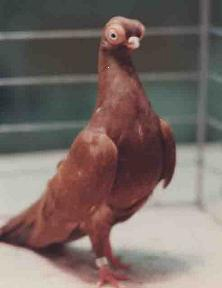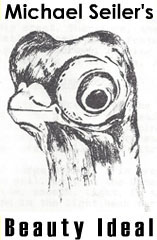Mike Seiler, Jackson, NJ February, 2017
Recessive red is the most challenging color variety to work with in any breed. The gene responsible for recessive red masks (epistasis) all color variations and patterns. However, some colors are better masked than others. This is exactly what this article will bring to light.
Many years ago when I started raising Short Face Viennas and Budapesters, I had the age old problem of producing a blood red pigeon with a “blue” tail. I would raise an outstanding bird that would be overlooked by a judge for a lesser quality pigeon with “better” color intensity like a black or a dun. This was frustrating to say the least because it is so difficult to raise any good Short Face let alone with excellent color.
The great Short Face breeder, Rudy Strnad, told me I was up against a tremendous obstacle and it would take me ten years to produce what I wanted in reds. He was quite right. Ironically, Rudy in previous years (1960’s) headed in another direction. Rudy used a tremendously beautiful red cock with a blue tail from Dr. Szecsenyi’s loft in Hungary to produce the dark beaked blue Budapesters known here as the Buda Blue.
Rudy suggested using duns in my breeding program to see what might happen. He recalled seeing what he referred to as “yellow” duns occasionally in Budapest. I had nothing to lose. Neither one of us at that time knew anything about pigeon genetics. (1970) I continued to work unsuccessfully for years with the color, but the time wasn’t wasted because the qualify of my flock was increasing all the time. The duns, I produced were short downed in the nest and I recorded them as such.
I had a very difficult time producing a dun cock, so I worked with the hens. Then a strange thing happened. Phil Salmieri, a well known Vienna breeder, gave me a “dun” cock to work with. I paired this cock to a yellow hen with the primary purpose of producing a dun cock of my own breeding. I did – at least I thought I did. The strange thing I noticed was that the youngsters were LONG downed. I passed this same original cock on to John Astino, another Vienna breeder, for his breeding program.
The following breeding season, I had the usual problem of pairing up various colors. I paired the “dun” males to red hens (blue tailed) with the hopes of producing yellows. I did not produce yellows. However, I did produce excellent red colored Viennas. Red from the tip of their beaks to the tips of their tails–blood red.. There were no rimmed tail feathers. So quite inadvertently, I have Phil Salmieri to thank for helping me to discover what is known as the brown gene in my own Short Face pigeons.
I had continued my work with the Viennas when I met John Thornton, a Domestic Flight breeder and we discussed this brown gene to some degree. He contributed the idea that brown genes are more prevalent in breeding flocks than breeders ever realized before. John reminded me of the fact that browns have tremendously beautiful eye color and ceres. This gene will, of course, show up in hens at the same rate as duns appear, but be long downed in the nest. Therefore, you must watch your youngsters closely. I have never produced a khaki hen, but I imported a hen some years ago that was a khaki. I had this hen several years but was unable to reproducing khaki. The young appeared very weak and died. Maybe, this is the lethal gene in Budapesters.
I immediately put all this information to work with my Budapesters. My goal was to produce beautiful reds with pale ceres and good eye color. I clicked at the first attempt. Now, I have applied this breeding technique to my long face Vienna High flyer foster parents as well.
Strangely enough while I was discovering these results in my breeding program, my contemporary, Rudy Ottenhoff of Holland, discovered this breakthrough as well in his Budapesters. On my second trip to Budapest in 1988, Rudy drove me throughout Europe and on our journey we discussed breeding techniques. We shared our knowledge of the browns, except Rudy called them chocolates. But I knew at once we were talking about browns. The only Short Face breeders that I shared this new information with, at the time, were Rudy Ottenhoff, Dr. Istvan Szecsenyi and Bobby Stockhousen – three close colleagues.
Now if you are going to try and produce good colored reds, try my methods. I know you’ll like it! Of course, yellows produced from browns are excellent in color as well with good blue eye color. Keep in mind you must return to blacks and blues for structure and vitality. The dilutes and recessives are generally weaker type pigeons.
Many of the breeders before us did not find all the solutions to breeding problems and we certainly will not discover them all either. This is what makes the breeding programs so exciting every year.
I have just one more bit of information on this topic to share. The beautiful red and yellow Short Face Komorners that Dr. Kiraly and I imported into this country both have long down in the nest. We could tell the yellows from the reds, but the yellows were the hairiest little things you ever saw. Had the Hungarians completely ‘painted’ red and yellow over the brown base color? These yellows are not naked like that found in some other breeds. We later learned that this was the GOLD gene. The following breeders could attest to the long downed yellows: Dr. Bela Kiraly (deceased now) , Bill Robinson, Jim Williams and George Colasacco.
My first blood red Budapest cock. Sometime in the early 1980’s

